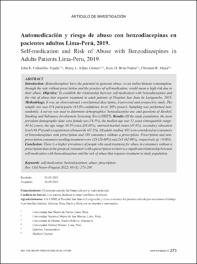Automedicación y riesgo de abuso con benzodiacepinas en pacientes adultos Lima-Perú, 2019

View/
Download
(application/pdf: 457.6Kb)
(application/pdf: 457.6Kb)
Date
2021-09-26Author(s)
Cabanillas-Tejada, John K.
Allpas-Gómez, Henry L.
Brito-Nuñez, Jesús D.
Mejia, Christian R.
Metadata
Show full item recordAbstract
“Introduction: Benzodiazepines have the potential to generate abuse, so an indiscriminate consumption,
through the sale without prescription and the practice of self-medication, would mean a high risk due to
their abuse. Objective: To establish the relationship between self-medication with benzodiazepines and
the risk of abuse that requires treatment in adult patients of Hospital San Juan de Lurigancho, 2019.
Methodology: It was an observational, correlational descriptive, transversal and prospective study. The
sample size was 874 participants (95.0% confidence level; 80% power). Sampling was performed nonrandomly. A survey was used to determine demographics, benzodiazepine use, and questions of Alcohol,
Smoking and Substance Involvement Screening Test (ASSIST). Results: Of the study population, the most
prevalent demographic data were female sex (74.5%), the median age was 52 years (interquartile range:
40-62 years), the age range 50-59 years (26.43%), married marital status (31.6%), secondary education
level (48.4%) and occupation as a housewife (47.3%). Of adults studied, 485 were considered as consumers
of benzodiazepines with prescription and 389 consumers without a prescription. Prescription and nonprescription consumers needing treatment were 129 (26.60%) and 245 (62.98%), respectively (p <0.001).
Conclusion: There is a higher prevalence of people who need treatment for abuse in consumers without a
prescription than in the group of consumers with a prescription so there is a significant relationship between
self-medication with benzodiazepines and the risk of abuse that requires treatment in study population.“
Collections
- SCOPUS [380]

